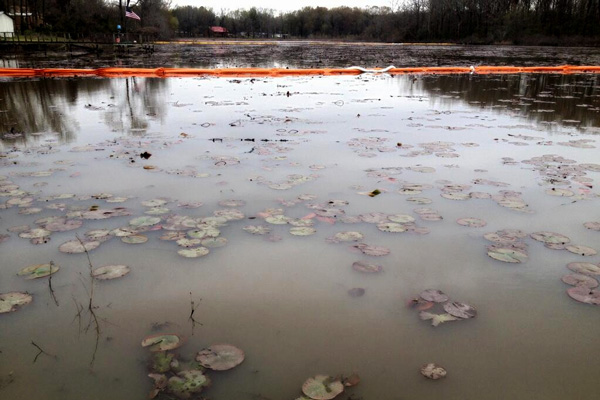
Tar Sands BlockadeDead vegetation in Lake Conway, which flows into the Arkansas River, a tributary of the Mississippi.
Rocker Neil Young wanted to see for himself the damage from ExxonMobil’s ruptured Pegasus oil pipeline, which recently spewed reeking, black goo into small-town Mayflower, Ark. So Young, a stalwart environmentalist, drove his revamped, super fuel-efficient hybrid 1959 Lincoln Continental into Mayflower on Monday, unannounced.
A few people snapped pictures with Young (local blogger Shelli Russell bumped into a telephone pole while chasing him down). But regardless of how cool his car is, it’s unlikely the famous singer got into the Northwoods neighborhood, where the pipeline ruptured. Round-the-clock security patrolmen still have the place tightly guarded for ExxonMobil, as they have from the beginning of the spill when it seemed the town was under martial law.
On his brief journey, Young undoubtedly saw crews without respirators working in an area locals call the Cove. They are hard to miss. The Cove — along with nearby Lake Conway, a popular fishing and boating spot — has become a point of contention in Mayflower.
ExxonMobil has insisted that it stopped the oil from seeping from the Cove into Lake Conway. But Mayflower residents and environmental activists say they smell something fishy, and it’s not in the lake. It is a scheme by ExxonMobil to make everything look copacetic, when in fact it is not. Considering what we now know about how BP handled the 2010 Deepwater Horizon oil spill in the Gulf of Mexico, that wouldn’t be surprising.
And one oil spill specialist isn’t taking ExxonMobil’s word. He says there’s crude in the lake, and he has the tests to prove it.
Scott Smith, CEO of the company Opflex Solutions, dropped a bombshell this week when he told a group of Mayflower residents that water samples tested by an independent lab show chemicals such as barium and methylene chloride — often found in tar-sands oil — in Lake Conway.
Many locals fish in Lake Conway and eat what they catch. Both barium and methylene chloride have been shown to cause health problems including cancer.
“Preliminary results show that the tar sands are not only in Lake Conway, but are moving beyond Lake Conway and toward the Arkansas River,” Smith told the group.
Smith’s company has created “reusable, highly buoyant, biodegradable open celled polyolefin foam” that soaks up oil. It was used in the BP oil spill in the Gulf and in subsequent spills around the world. He says he offered this technology to ExxonMobil, but the company refused to use it.
ExxonMobil and the Arkansas Department of Environmental Quality (ADEQ) insist that the main body of Lake Conway remains free of the tar-sands oil. In a press release on Tuesday, the ADEQ said it takes samples twice a week at a total of 20 sites in the Cove and the main body of the lake.
But Smith says while the ADEQ and ExxonMobil test the lake’s surface and soil samples from the bottom of the lake, he is concerned about the water in between. The solvents in tar-sands oil don’t simply sink to the bottom of a lake, he says, but rather they float in the water column, especially when it rains, as it has over the past few weeks.
And if there is oil in Lake Conway, it will likely spread. “There’s a strong current that flows from the lake to the river,” Smith says.
If he is correct, the oil spill would certainly have more far-reaching consequences. The Arkansas River is a major recreation and fishing destination. It flows into to the Mississippi River and subsequently to the Gulf of Mexico.
ADEQ Director Teresa Marks says that the agency is “willing to review credible data from independent parties should that data be made available to ADEQ.” But that’s cold comfort to locals.
Genieve Long, who has lived on the banks of the Cove for 28 years, says she told Smith where to take samples because certain creeks that connect to the lake — and ultimately the Arkansas River — have flooded from torrential spring rains.
“I feel like there is a cover-up,” Long says. “I walk onto my front porch and I see the lake and I have seen the oil sheen that flows past.”
The 22 houses that were evacuated immediately after the rupture remain empty. Some families have had the option of returning but have not. Still, ExxonMobil announced in a news release Tuesday, “The majority of freestanding oil has been contained or cleaned up.” The company is now phasing into a “longer-term remediation phase.”
Long, who was never given the option to evacuate, worries about the long-term consequences of the spill. She says she fears the whole town is contaminated with tar-sands oil, considering workers have gone into Harp’s, the local grocery store, and restaurants wearing grimy hazmat suits.
“They won’t be here for the long haul,” Long says of ExxonMobil. “They are going to pack up and leave and the people are going to have to deal with the repercussions.”



